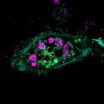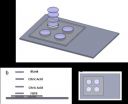(Press-News.org) PROVIDENCE, R.I. – In a recent study, researchers at Rhode Island Hospital found that fear of being rejected because of one's appearance, as well as rejection sensitivity to general interpersonal situations, were significantly elevated in individuals with Body Dysmorphic Disorder (BDD). These fears, referred to as personal rejection sensitivity and appearance-based rejection sensitivity, can lead to diminished quality of life and poorer mental and overall health. BDD is a common, often severe, and under-recognized body image disorder that affects an estimated 1.7 to 2.4 percent of the population. The study is published in the current issue of the journal Body Image.
"People with BDD obsess about physical features or attributes that they believe are ugly or hideous, often spending hours looking in the mirror and taking extraordinary measures to try to correct imperfections that only they can see," said Katharine Phillips, M.D., director of the Body Dysmorphic Disorder program at Rhode Island Hospital, and senior author of the study. "So they are particularly sensitive to what they believe is rejection from others based on these or other perceived flaws."
She continued, "This study suggests that those with BDD experience an increased expectation of personal rejection, often to the detriment of their overall health and quality of life."
The study found that personal rejection sensitivity was associated with more severe BDD and depressive symptoms, poorer mental health, general health, and physical and social functioning, while appearance-based rejection sensitivity was associated with more severe BDD and depressive symptoms, and poorer general health. Personal rejection sensitivity is defined as the tendency by an individual to worry that others will negatively evaluate and reject them. Clinical observations additionally suggest that personal rejection sensitivity is common in persons with BDD. A more specific type of rejection sensitivity, appearance-based rejection sensitivity, also may be a key characteristic of BDD. Appearance-based rejection sensitivity is defined as anxiety-provoking expectations of social rejection based on physical appearance
"Generally speaking, no one enjoys being rejected or feeling embarrassed," Phillips said. "But for people with BDD, feelings of being rejected by others are exacerbated, sometimes to the point where individuals are debilitated by these concerns, even if the rejection was simply perceived, not real."
BDD typically starts during early adolescence. The disorder consists of intrusive, time-consuming preoccupations about perceived defects in one's physical appearance (for example, acne, hair loss, or nose size) whereas the perceived flaws are actually minimal or even nonexistent in the eyes of others. Individuals with BDD may engage in obsessive grooming, skin picking or plastic surgery (which appears to usually be ineffective). BDD also often leads to social impairments, missed work or school and difficulty forming and maintaining meaningful relationships. It is associated with high lifetime rates of psychiatric hospitalization and suicide.
"More research is needed to help patients and their families better understand BDD and associated rejection sensitivity. Studies are also needed to help clinicians determine the best treatment to help patients who are suffering with BDD lead lives that are as productive and satisfying as possible," Phillips said.
INFORMATION:
The study was supported through grants from the National Institutes of Mental Health awarded to Katharine Phillips, M.D., (R01MH60241 and 5K24MH063975); and the VISN 1 Early Career Development Award from the Department of Veterans Affairs, Veterans Health Administration, awarded to Megan M. Kelly. Phillips' principal affiliation is Rhode Island Hospital, a member hospital of the Lifespan health system in Rhode Island. She is also a member of the Department of Psychiatry and Human Behavior at The Warren Alpert Medical School of Brown University. Other researchers involved in the study were Elizabeth Didie of the Alpert Medical School; and Megan M. Kelly of the Edith Nourse Rogers Memorial Veterans Hospital in Bedford, Massachusetts; the University of Massachusetts Medical School, and the Alpert Medical School.
About Rhode Island Hospital
Founded in 1863, Rhode Island Hospital in Providence, R.I., is a private, not-for-profit hospital and is the principal teaching hospital of The Warren Alpert Medical School of Brown University. A major trauma center for southeastern New England, the hospital is dedicated to being on the cutting edge of medicine and research. Last year, Rhode Island Hospital received more than $55 million in external research funding. It is also home to Hasbro Children's Hospital, the state's only facility dedicated to pediatric care. For more information on Rhode Island Hospital, visit http://www.rhodeislandhospital.org, follow us on Twitter @RIHospital or like us on Facebook http://www.facebook.com/rhodeislandhospitalpage.
Study: Body Dysmorphic Disorder patients have higher risk of personal and appearance-based rejection sensitivity
Rejection sensitivities impact overall health and quality of life
2014-07-15
ELSE PRESS RELEASES FROM THIS DATE:
Prostate cancer in young men -- More frequent and more aggressive?
2014-07-15
ANN ARBOR, Mich. -- The number of younger men diagnosed with prostate cancer has increased nearly 6-fold in the last 20 years, and the disease is more likely to be aggressive in these younger men, according to a new analysis from researchers at the University of Michigan Comprehensive Cancer Center.
Typically, prostate cancer occurs more frequently as men age into their 70s or 80s. Many prostate cancers are slow-growing and many older men diagnosed with early stage prostate cancer will end up dying from causes other than prostate cancer.
But, the researchers found, ...
Rollout strategy for diagnostic test in India may impact TB
2014-07-15
Xpert MTB/RIF, a recently implemented tuberculosis (TB) test, has the potential to control the TB epidemic in India, but only if the current, narrow, implementation strategy is replaced by a more ambitious one that is better funded, also includes the private sector, and better referral networks are developed between public and private sectors, according to new research published in this week's PLOS Medicine. The study by David Dowdy, from Johns Hopkins University, United States, and colleagues is a mathematical model that suggests alternative strategies that include engagement ...
Molecular 'eat now' signal makes cells devour dying neighbors
2014-07-15
A team of researchers has devised a Pac-Man-style power pellet that gets normally mild-mannered cells to gobble up their undesirable neighbors. The development may point the way to therapies that enlist patients' own cells to better fend off infection and even cancer, the researchers say.
A description of the work will be published July 15 in the journal Science Signaling.
"Our goal is to build artificial cells programmed to eat up dangerous junk in the body, which could be anything from bacteria to the amyloid-beta plaques that cause Alzheimer's to the body's own ...
Neurons, brain cancer cells require the same little-known protein for long-term survival
2014-07-15
CHAPEL HILL, N.C. – Researchers at the UNC School of Medicine have discovered that the protein PARC/CUL9 helps neurons and brain cancer cells override the biochemical mechanisms that lead to cell death in most other cells. In neurons, long-term survival allows for proper brain function as we age. In brain cancer cells, though, long-term survival contributes to tumor growth and the spread of the disease.
These results, published in the journal Science Signaling, not only identify a previously unknown mechanism used by neurons for their much-needed survival, but show that ...
Rollout strategy is key to battling India's TB epidemic, researchers find
2014-07-15
A new study led by Johns Hopkins Bloomberg School of Public Health researchers suggests that getting patients in India quickly evaluated by the right doctors can be just as effective at curbing tuberculosis (TB) as a new, highly accurate screening test.
While ideally all suspected TB cases would be evaluated with the new test, it is primarily being used only on the highest-risk populations and only in public health clinics, partly because of its cost and the complexity of the nation's health care system. This slows diagnosis of a disease that must be caught early, the ...
New assay to spot fake malaria drugs could save thousands of lives
2014-07-15
CORVALLIS, Ore. – Chemists and students in science and engineering at Oregon State University have created a new type of chemical test, or assay, that's inexpensive, simple, and can tell whether or not one of the primary drugs being used to treat malaria is genuine – an enormous and deadly problem in the developing world.
The World Health Organization has estimated that about 200,000 lives a year may be lost due to the use of counterfeit anti-malarial drugs. When commercialized, the new OSU technology may be able to help address that problem by testing drugs for efficacy ...
3-D nanostructure could benefit nanoelectronics, gas storage
2014-07-15
A three-dimensional porous nanostructure would have a balance of strength, toughness and ability to transfer heat that could benefit nanoelectronics, gas storage and composite materials that perform multiple functions, according to engineers at Rice University.
The researchers made this prediction by using computer simulations to create a series of 3-D prototypes with boron nitride, a chemical compound made of boron and nitrogen atoms. Their findings were published online July 14 in the Journal of Physical Chemistry C.
The 3-D prototypes fuse one-dimensional boron nitride ...
TGen-led study finds likely origin of lung fungus invading Pacific Northwest
2014-07-15
FLAGSTAFF, Ariz. - Cryptococcus gattii, a virulent fungus that has invaded the Pacific Northwest is highly adaptive and warrants global "public health vigilance," according to a study by an international team led by the Translational Genomics Research Institute (TGen).
C. gattii, which likely originated in Brazil, is responsible for dozens of deaths in recent years since it was first found in 1999 on Vancouver Island, British Columbia, Canada, well outside its usual tropical habitats.
"We identified several genes that may make the outbreak strains more capable of surviving ...
Rice nanophotonics experts create powerful molecular sensor
2014-07-15
Nanophotonics experts at Rice University have created a unique sensor that amplifies the optical signature of molecules by about 100 billion times. Newly published tests found the device could accurately identify the composition and structure of individual molecules containing fewer than 20 atoms.
The new imaging method, which is described this week in the journal Nature Communications, uses a form of Raman spectroscopy in combination with an intricate but mass reproducible optical amplifier. Researchers at Rice's Laboratory for Nanophotonics (LANP) said the single-molecule ...
SLU scientists hit 'delete': Removing regions of shape-shifting protein explains how blood clots
2014-07-15
ST. LOUIS – In results recently published in Proceedings of the National Academy of Sciences (PNAS), Saint Louis University scientists have discovered that removal of disordered sections of a protein's structure reveals the molecular mechanism of a key reaction that initiates blood clotting.
Enrico Di Cera, M.D., chair of the Edward A. Doisy department of biochemistry and molecular biology at Saint Louis University, studies thrombin, a key vitamin K-dependent blood-clotting protein, and its inactive precursor prothrombin (or coagulation factor II).
"Prothrombin is essential ...
LAST 30 PRESS RELEASES:
Tracing the quick synthesis of an industrially important catalyst
New software sheds light on cancer’s hidden genetic networks
UT Health San Antonio awarded $3 million in CPRIT grants to bolster cancer research and prevention efforts in South Texas
Third symposium spotlights global challenge of new contaminants in China’s fight against pollution
From straw to soil harmony: International team reveals how biochar supercharges carbon-smart farming
Myeloma: How AI is redrawing the map of cancer care
Manhattan E. Charurat, Ph.D., MHS invested as the Homer and Martha Gudelsky Distinguished Professor in Medicine at the University of Maryland School of Medicine
Insilico Medicine’s Pharma.AI Q4 Winter Launch Recap: Revolutionizing drug discovery with cutting-edge AI innovations, accelerating the path to pharmaceutical superintelligence
Nanoplastics have diet-dependent impacts on digestive system health
Brain neuron death occurs throughout life and increases with age, a natural human protein drug may halt neuron death in Alzheimer’s disease
SPIE and CLP announce the recipients of the 2025 Advanced Photonics Young Innovator Award
Lessons from the Caldor Fire’s Christmas Valley ‘Miracle’
Ant societies rose by trading individual protection for collective power
Research reveals how ancient viral DNA shapes early embryonic development
A molecular gatekeeper that controls protein synthesis
New ‘cloaking device’ concept to shield sensitive tech from magnetic fields
Researchers show impact of mountain building and climate change on alpine biodiversity
Study models the transition from Neanderthals to modern humans in Europe
University of Phoenix College of Doctoral Studies releases white paper on AI-driven skilling to reduce burnout and restore worker autonomy
AIs fail at the game of visual “telephone”
The levers for a sustainable food system
Potential changes in US homelessness by ending federal support for housing first programs
Vulnerability of large language models to prompt injection when providing medical advice
Researchers develop new system for high-energy-density, long-life, multi-electron transfer bromine-based flow batteries
Ending federal support for housing first programs could increase U.S. homelessness by 5% in one year, new JAMA study finds
New research uncovers molecular ‘safety switch’ shielding cancers from immune attack
Bacteria resisting viral infection can still sink carbon to ocean floor
Younger biological age may increase depression risk in older women during COVID-19
Bharat Innovates 2026 National Basecamp Showcases India’s Most Promising Deep-Tech Ventures
Here’s what determines whether your income level rises or falls
[Press-News.org] Study: Body Dysmorphic Disorder patients have higher risk of personal and appearance-based rejection sensitivityRejection sensitivities impact overall health and quality of life




